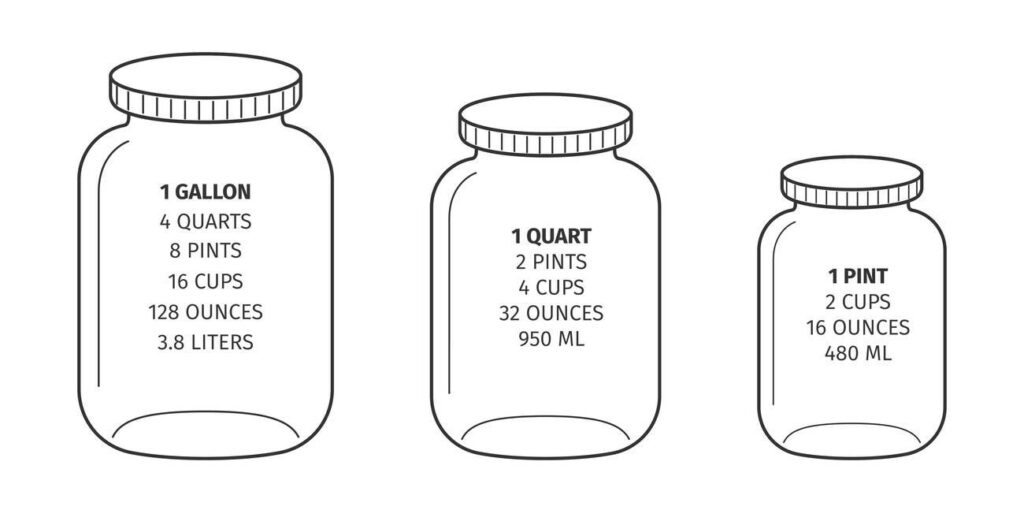Excel in Cooking With Fluid Ounce to Gallon Conversions
Have you ever found yourself in the middle of a recipe where one ingredient requires measuring in ounces but the recipe specifies gallons? It can be an upsetting and confusing situation – especially since precision in food and baking matters! But don’t despair: many home chefs struggle with understanding how many fluid ounces comprise one gallon.
This blog post is here to make conversion easier, making your time in the kitchen more enjoyable and less stressful. With helpful charts, calculations and tips for converting ounces to gallons you will soon become adept at accurately measuring ingredients ensuring every recipe turns out perfectly every time!
Understanding Fluid Ounces and Gallons Is of Great Importance
Understanding fluid ounces and gallons conversions is a key component of cooking accurately at home. By having this knowledge at their disposal, they can ensure their dishes have the desired consistency and flavor profile.
Imagine yourself making homemade soup for a crowd and your recipe calls for gallon(s) of broth – without knowing the exact number of ounces that make up one gallon, your result could end up with too much or too little liquid, which would alter both texture and taste of your final product.
Accurate measurements help prevent food waste. By measuring out each ingredient correctly, you’ll avoid overbuying and wasting food, saving both money and waste in the long run.
Understanding Ounces and Gallons (FOGS)
Let’s first discuss what fluid ounces and gallons are. A fluid ounce is a unit of volume used for measuring liquids; commonly abbreviated “fl oz.” Meanwhile, gallon volume units measure larger quantities of liquid.
United States gallon measurements correspond to 128 fluid ounces; however, in the UK one gallon equals 160 fluid ounces – this difference in measurement can be critical when trying out recipes from other countries.
Compare Imperial Gallons vs US Gallon
Home cooks may find the differences between US gallons and Imperial gallons confusing, particularly since US gallon is smaller. As a result, its number of fluid ounces per gallon differs significantly.
Example: A British recipe may call for one gallon of milk, while using US gallon units will result in less milk being available than needed for that recipe. Any deviation can alter its outcome, so it is imperative to know which measurement system your recipe utilizes.
How Many Fluid Ounces Make Up A Gallon of Milk in America?
One gallon in US measurement terms equals 128 fluid ounces – this ratio makes measuring water, milk or any other liquid easy and straightforward.
If a recipe calls for half gallon of broth, measure out 64 fluid ounces; similarly a quarter gallon would require 32 fluid ounces and so forth. Knowing these conversions makes cooking and baking much faster and efficient.
What Are the Volumetric Capacity Dimensions for an Imperial Gallon?
Under Imperial measurement systems, one gallon equals 160 fluid ounces – this system is most frequently employed in the UK and certain other Commonwealth countries.
If you’re following a British recipe, be aware of any conversions required in terms of measurements. For instance, half an Imperial gallon corresponds to 80 fluid ounces while quarter gallon equals 40 fluid ounces – knowing these conversions ensures you use the appropriate amounts for all ingredients.
Home Cooks can benefit from using this handy Conversion Chart
As an additional aid, here’s a handy conversion chart for converting fluid ounces to gallons – this table includes both US and Imperial measures so that your recipe will still work regardless of where it originates from.
| Measurement | US Gallons | Imperial Gallons |
|---|---|---|
| 1 fluid ounce | 0.0078 gallons | 0.00625 gallons |
| 16 fluid ounces (1 pint) | 0.125 gallons | 0.1 gallons |
| 32 fluid ounces (1 quart) | 0.25 gallons | 0.2 gallons |
| 64 fluid ounces (1/2 gallon) | 0.5 gallons | 0.4 gallons |
| 128 fluid ounces (1 gallon) | 1 gallon | 0.8 gallons |
| 160 fluid ounces | 1.25 gallons | 1 gallon |
This chart can serve as an indispensable asset in your kitchen, helping you quickly and accurately convert fluid ounces to gallons.
Tips for Accurate Measurements
Accurate measurements are key to successful cooking and baking. Here are some tips that can help you measure ingredients more precisely:
Use the right tools: Make sure that you invest in a quality set of measuring cups and spoons; for liquids, clear measuring cups equipped with spouts can accurately measure liquid measurements.
Level Off Dry Ingredients: When measuring dry ingredients, use a knife or straight edge to level off the top of the measuring cup or spoon in order to ensure you’re not adding too much or too little of each ingredient. This way you’ll ensure accurate measurements.
Measure at eye level: When measuring liquids, place your measuring cup on a flat surface and check its contents at eye level to avoid either overfilling or underfilling your cup. This ensures accurate readings that will prevent both overfilling or underfilling situations from arising.
Even experienced home chefs can make mistakes when it comes to measurements, here are a few common pitfalls you should be wary of:
Confusion Between Weight and Volume: Keep in mind that fluid ounces represent volume rather than weight; don’t confuse fluid ounces with ounces, which measure weight.
Neglecting temperature changes: Liquids can expand or contract with temperature variations, so for accurate results it is best to measure liquids at room temperature when measuring them.
Disregarding recipe specifications: For optimal results, always follow the measurements and instructions of a recipe exactly. Whether using US or Imperial measurements, follow them for optimal results.
Why Consistency Is Key in Cooking
Consistency in cooking is key when it comes to measurements. By adding just the right amount of each ingredient, your dish is sure to come out perfectly every time.
Even small variations in liquid usage can dramatically change the texture and structure of baked goods, creating significant variations between batches. Excess liquid can make dough too sticky while too little causes it to dry out too fast.
Consistent measurements also help you recreate the same recipes again and again, without fail. Once you’ve perfected one dish, following its measurements every time is the key to duplicating its perfection!
How to Convert Recipes Using Different Measures (PDF).
Sometimes you might need to adapt a recipe according to the measurements available to you. Here’s how:
Scaling Up or Down: When multiplying or halving a recipe, simply adjust its measurements proportionately; for instance doubling all ingredient quantities equals doubling of all measurements in that recipe.
Convert Units: Use conversion charts like those provided above to convert measurements between units, so you use exactly the right amount of each ingredient regardless of how it was specified in your recipe.
Test and Adjust: Before making changes to a recipe, always do a trial run first and adjust as necessary. For instance, increasing the liquid quantity could require making necessary adjustments in terms of cooking time or temperature in order to achieve the best results.
Home Cooks Can Benefit From Knowing Conversions for Meal Prep
Knowledge of how to convert fluid ounces to gallons has several advantages for home cooks:
Accurate measurements ensure your dishes always turn out deliciously.
Understanding conversions allows you to adapt recipes according to your specific needs, whether scaling up for a large gathering or down for intimate family meals.
Confidence: Learning how to measure ingredients accurately provides you with the confidence to explore new recipes and experiment in the kitchen.
Exploring New Recipes with Confidence
Now that you possess an understanding of fluid ounce to gallon conversions, you can confidently explore new recipes with accurate measurements. From classic soup dishes to innovative baking techniques, accurate measurements will ensure optimal results.
Do not be intimidated to venture outside your comfort zone and try recipes from other cuisines. Understanding conversions will make following recipes from around the world much simpler, broadening your culinary horizons in the process.
Mastering fluid ounce to gallon conversions is an invaluable skill for any home chef. Accurate measurements, consistent results, and the flexibility to customize recipes according to individual tastes all benefit from learning this vital tradecraft. With this guide’s practical tips and conversion chart at your disposal, you will be well equipped to take on any recipe with confidence.
Happy cooking! By understanding how many fluid ounces make up a gallon and becoming adept with these conversions, you’ll improve your culinary skills and find more success when cooking. For additional tips and resources that can help strengthen your kitchen prowess, be sure to explore our blog posts and resources.

